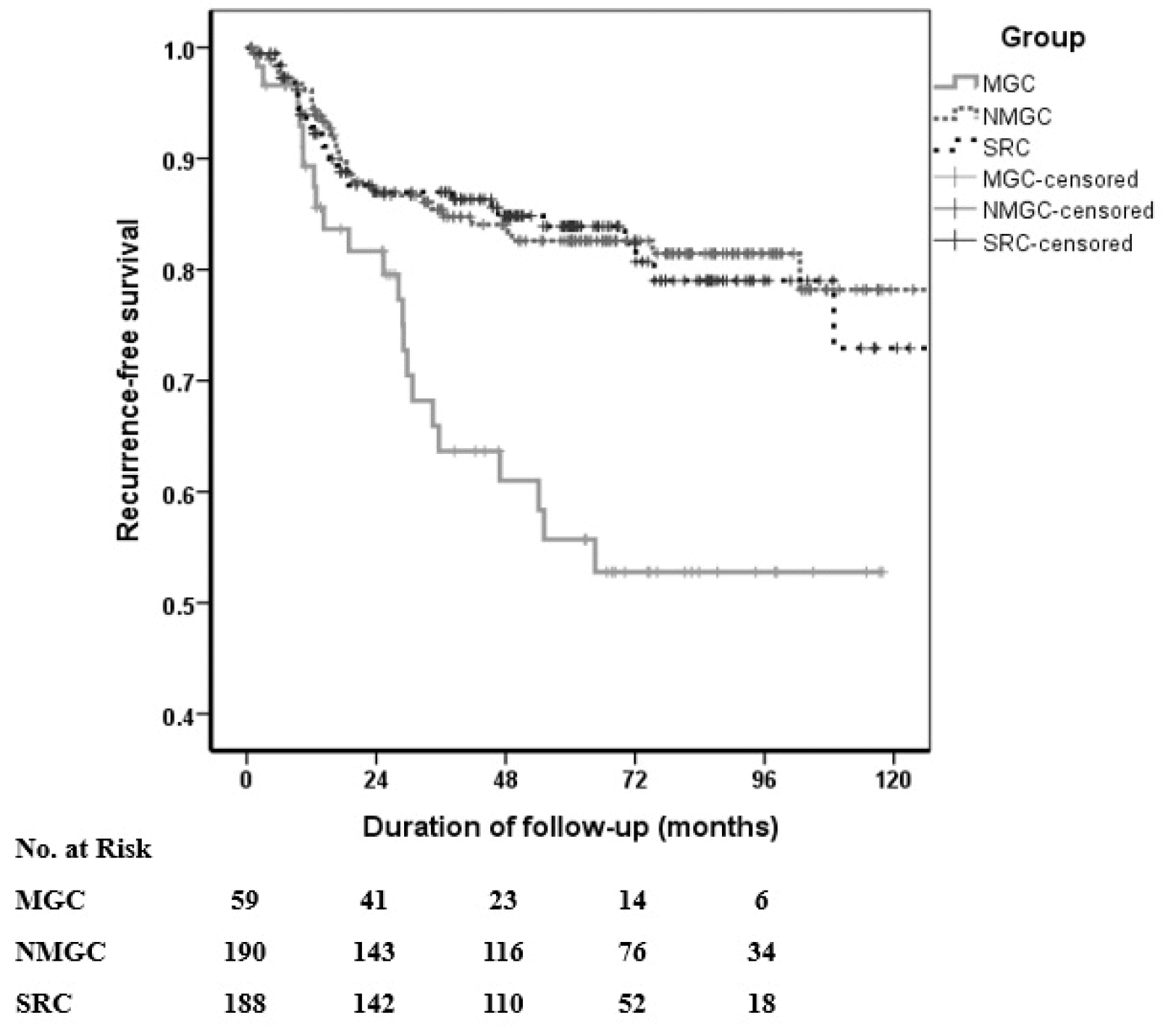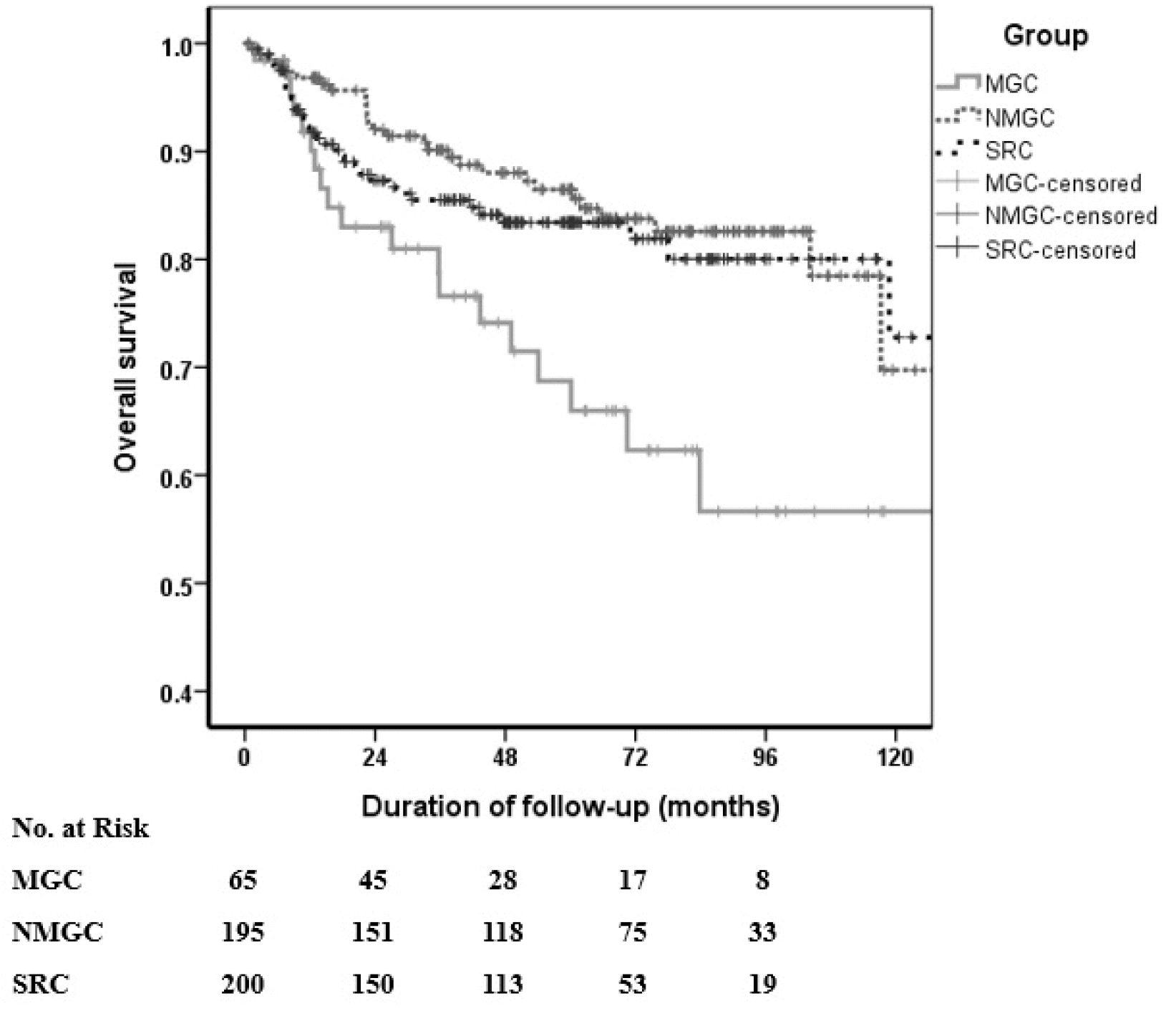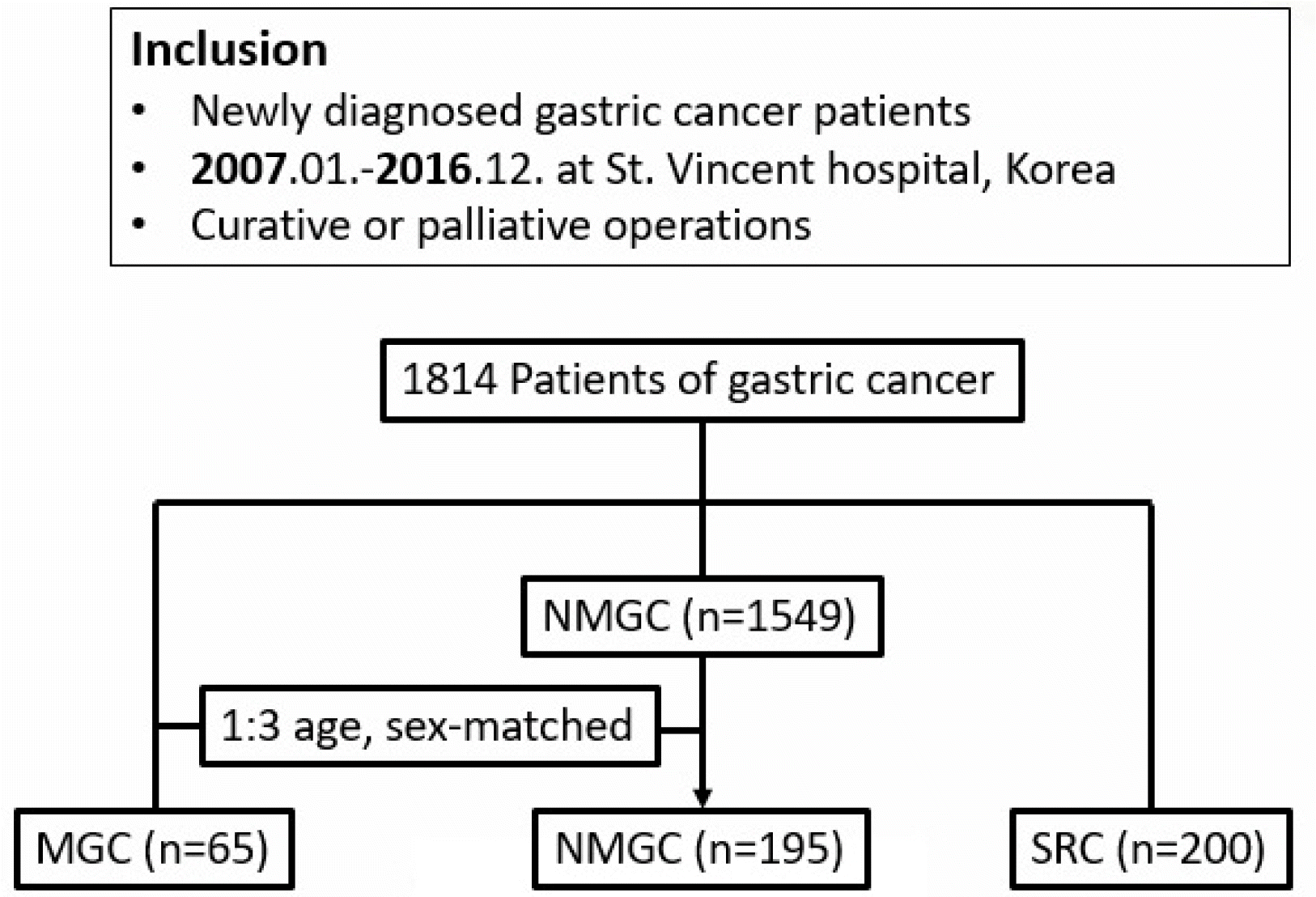1. Bray F, Ferlay J, Soerjomataram I, Siegel RL, Torre LA, Jemal A. 2018; Global cancer statistics 2018: GLOBOCAN estimates of incidence and mortality worldwide for 36 cancers in 185 countries. CA Cancer J Clin. 68:394–424. DOI:
10.3322/caac.21492. PMID:
30207593.

2. Kunisaki C, Akiyama H, Nomura M, et al. 2006; Clinicopathologic characteristics and surgical outcomes of mucinous gastriccarcinoma. Ann Surg Oncol. 13:836–842. DOI:
10.1245/ASO.2006.03.077. PMID:
16604474.
3. Zhang M, Zhu GY, Zhang HF, Gao HY, Han XF, Xue YW. 2010; Clinicopathologic characteristics and prognosis of mucinous gastric carcinoma. J Surg Oncol. 102:64–67. DOI:
10.1002/jso.21533. PMID:
20578080.

4. Zhang M, Zhu G, Zhang H, Gao H, Xue Y. 2010; Clinicopathologic features of gastric carcinoma with signet ring cell histology. JGastrointest Surg. 14:601–606. DOI:
10.1007/s11605-009-1127-9. PMID:
20033340.

5. Kwon KJ, Shim KN, Song EM, et al. 2014; Clinicopathological characteristics and prognosis of signet ring cell carcinoma of the stomach. Gastric Cancer. 17:43–53. DOI:
10.1007/s10120-013-0234-1. PMID:
23389081.

6. Choi JS, Kim MA, Lee HE, Lee HS, Kim WH. 2009; Mucinous gastric carcinomas: clinicopathologic and molecular analyses. Cancer. 115:3581–3590. DOI:
10.1002/cncr.24422. PMID:
19479974.
7. Jian-Hui C, Shi-Rong C, Hui W, et al. 2016; Gastric mucinous cancer histology: clinicopathological characteristics and prognostic value. Gastroenterol Res Pract. 2016:8947505. DOI:
10.1155/2016/8947505. PMID:
26839544. PMCID:
PMC4709619.

8. Jiang H, Zhang H, Tian L, Zhang X, Xue Y. 2013; The difference in clinic-pathological features between signet ring cell carcinoma and gastric mucinous adenocarcinoma. Tumour Biol. 34:2625–2631. DOI:
10.1007/s13277-013-0812-1. PMID:
23636798.

9. Bu Z, Zheng Z, Li Z, et al. 2013; Clinicopathological and prognostic differences between mucinous gastric carcinoma and signet-ringcell carcinoma. Chin J Cancer Res. 25:32–38.
10. Kawamura H, Kondo Y, Osawa S, et al. 2001; A clinicopathologic study of mucinous adenocarcinoma of the stomach. Gastric Cancer. 4:83–86. DOI:
10.1007/PL00011728. PMID:
11706765.

11. Lim SW, Kim DY, Kim YJ, Kim SK. 2002; Clinicopathologic features ofmucinous gastric carcinoma. Dig Surg. 19:286–290. DOI:
10.1159/000064583. PMID:
12207072.
13. Yasuda K, Shiraishi N, Inomata M, Shiroshita H, Ishikawa K, Kitano S. 2004; Clinicopathologic characteristics of early-stage mucinous gastric carcinoma. J Clin Gastroenterol. 38:507–511. DOI:
10.1097/01.mcg.0000128991.59549.9a. PMID:
15220686.

15. Ajani JA IH, Sano T, Gaspar LE, et al. Amin MB, Greene FL, Edge SB, editors. 2017. Stomach. AJCC cancer staging manual. 8th ed. Springer;New York: p. 203–220. DOI:
10.1007/978-3-319-40618-3_17.
16. Isobe T, Hashimoto K, Kizaki J, et al. 2015; Characteristics and prognosis of mucinous gastric carcinoma. Mol Clin Oncol. 3:44–50. DOI:
10.3892/mco.2014.447. PMID:
25469268. PMCID:
PMC4251105.

17. Yuan Y, Chen Z, Chen J, et al. 2018; Mucinous gastric carcinoma: an update of clinicopathologic features and prognostic value from aretrospective study of clinical series. Int J Clin Exp Pathol. 11:813–821.
18. Shin SH, Bae JM, Jung H, et al. 2010; Clinical significance of the discrepancy between preoperative and postoperative diagnoses in gastric cancer patients. J Surg Oncol. 101:384–388. DOI:
10.1002/jso.21500. PMID:
20127892.

20. Hyung WJ, Noh SH, Shin DW, et al. 1999; Clinicopathologic characteristics of mucinous gastric adenocarcinoma. Yonsei Med J. 40:99–106. DOI:
10.3349/ymj.1999.40.2.99. PMID:
10333711.

21. Pernot S, Voron T, Perkins G, Lagorce-Pages C, Berger A, Taieb J. 2015; Signet-ring cell carcinoma of the stomach: impact on prognosis and specific therapeutic challenge. World J Gastroenterol. 21:11428–11438. DOI:
10.3748/wjg.v21.i40.11428. PMID:
26523107. PMCID:
PMC4616218.

22. Chon HJ, Hyung WJ, Kim C, et al. 2017; Differential prognostic implications of gastric signet ring cell carcinoma: stage adjustedanalysis from a single high-volume center in Asia. Ann Surg. 265:946–953. DOI:
10.1097/SLA.0000000000001793. PMID:
27232252. PMCID:
PMC5389602.






 PDF
PDF Citation
Citation Print
Print






 XML Download
XML Download